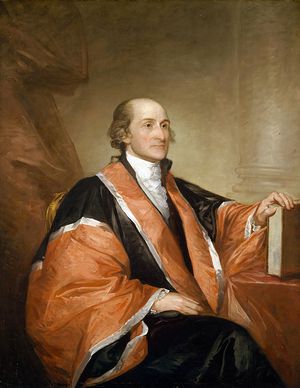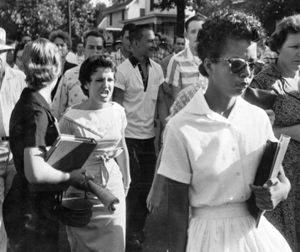Difference between revisions of "What is the early history of the United States Supreme Court"
(→Summary) |
|||
| Line 28: | Line 28: | ||
==References== | ==References== | ||
| + | <references/> | ||
| + | {{Contrinbutors}} | ||
Revision as of 21:12, 3 June 2019
The Supreme Court of the United States was considered critical as part of the checks and balances that formed how the United States was to be governed. The idea of such a court emerged during early Constitutional debates in 1787. The Supreme Court of today, however, has changed but still plays the ultimate arbiter in interpreting legislation.
The Early Court
The Supreme Court opened its first session in February 1790 in New York City, the then capital of the United States. Later in 1790, it moved to Philadelphia, which also became the capital, where the court met in Independence Hall. Initially, the court was made up of six justices, where it was envisioned that a two-thirds majority would be needed for any decision. The court did not have a permanent nine members until 1869, when that number was established as precedent. The justices were given lifetime appointments because it was seen as a way to avoid them being influenced by a sitting president. The first case to be litigated before the court, West v. Barnes, involved procedural issues, in particular, the procedures of appeal. There were few major cases in the 1790s and the court lacked a permanent home. The first major case was Chisholm v. Georgia, which saw Chisholm sue the state of Georgia. The case influenced the 11th Amendment to the Constitution, which allowed individuals to sue states based on state consent (Figure 1).[1]
The most influential figure in the early Supreme Court was justice John Marshal (1801-1835. This was the period when the concept of judicial review became an established precedent that has influenced subsequent acts by the Court to review legislation as they come up. Arguably, the Supreme Court developed more into something more similar to its modern form during the Marshal years. For instance, the concept of a review of Constitutional issues became fully established by this time and many practices, including issuing a single majority opinion by the Court, became established during this time. One influential case was the impeachment of Justice Samuel Chase. He was accused of partisan bias and the case that involved his impeachment influenced and shaped the idea that the Supreme Court must be kept an independent part of the government. In effect, the Court attempted to make a more complete break from partisan politics and established a precedent to be an independent reviewer of legislation and judgment of following the laws of the United States.[2]
Arguably the most impactful Supreme Court decision helped create the fault lines that became the Civil War. The Dred Scott v. Sandford in 1857 case, under Chief Justice Robert Taney, established that American citizenship was not to be given to black people, regardless if they were free or slave. Effectively this made all blacks not have citizenship rights. Ultimately the 14th Amendment overturned this decision. The Dred Scott v. Sandford case also influenced subsequent legislation in avoiding a similar case and what ultimately would become the concept of substantive due process, which protected the rights of individuals even if their rights were not explicit in the Constitution. This not only helped prevent a repeat of The Dred Scott v Sandfor case but it became established as legal precedent under the Chief Justice Waite and Fuller courts in the late 19th century through several cases.[3]
The Early 20th Century
During the earliest years of the 20th century, the boundaries of free speech and the 1st Amendment were not clear and states did ban certain publications. The case of Gitlow v. New York in 1925 established more clear guidelines as to what constituted free speech and protection under the 1st Amendment. This case greatly restricted the powers of states to suppress publications or speech by individuals. The Adkins v. Children's Hospital case in 1923 first established precedent on due process in the 5th Amendment, further protecting individuals' rights from states or organizations that infringed on those rights such as in work requirements and payment. In the 1930s to 1953 saw a substantial number of court decisions that sided with the federal government and that enhanced government powers, in part as a reaction to major crises. This included granting greater power for Roosevelt to apply the New Deal legislation he had worked to pass in the 1930s. Perhaps the most controversial was the Court's decision that upheld the government's power to intern Japanese-American citizens during World War II, arguably also a complete reversal of earlier decisions that had enhanced civil rights. The two major crises, the Great Depression and World War II, may have influenced court action to face these crises more than political leaning for parties by giving the federal government greater powers. [4]
The Cold War Court
Earl Warren, Chief Justice from 1953-1969, led perhaps the most influential period that enhanced a series of civil liberties. One of the most famous cases was Brown v. Board of Education which began the long process of desegregation in public schools and influenced desegregation in general across the United States (Figure 2). Additionally, Reynolds v. Sims forced states to reapportion their legislatures according to changing populations. Thus, districts have to be somewhat equal as to how they apportioned representation. Previously, low population places could be used to influence the legislative process, which in the South had led to restrictive laws against African Americans. Also, the role of religion in schools was severely limited by the case of Engel v. Vitale. Another landmark case was Gideon v. Wainwright, which required, under the 6th Amendment, states appoint an attorney for defendants in criminal cases. The Miranda rights, which are given in cases where police detain a suspect, were also a result of the Miranda v. Arizona case, another landmark that has greatly influenced the criminal justice system.[5]
The court, arguably, took a more conservative turn in the 1970s under the Burger court, that existed until 1986. Nevertheless, one of the most landmark cases, Roe v. Wade protected individuals' rights to abortion and prevented states from creating restrictive laws against abortion access and upheld affirmative action in University of California v. Bakke. It still remains one of the most polarizing decisions by the Supreme Court. The Court, however, struck down earlier cases that limited campaign finance in Buckley v. Valeo. The Rehnquist Court, from 1986-2005, generally upheld individual rights, such as Lawrence v. Texas that struck down Texas' sodomy law. The most controversial decision was its involvement in the 2000 election in Bush v. Gore that ended the recount of the election. The court, under Chief Justice John Roberts, is seen as generally being conservative, but key decisions such as United States v. Windsor led to the decision that part of the Defense of Marriage Act (DOMA) legislation was unconstitutional and gay and lesbian couples cannot be discriminated on in relation to benefits and rights in cases where they are married.[6]
The main controversies today in the Supreme Court, interestingly, are not different from one of the first impeachments in the United States, which had to do with a Justice being perceived as being politically influenced. There are clear and well documents cases where Justices were not impartial, such as in the Dredd Scott case. However, the topic itself remains contentious and the recent appointment of Brett Kavanaugh and the process of his appointing support this. Nevertheless, repeatedly judges nominated by left-leaning or right-leaning presidents often do not follow their perceived political bent, perhaps indicating that the Court has at times maintained a level of independence as envisioned early in its history. [7]
Summary
The Supreme Court has had a major influence on the United States, often upholding or often reversing legislation passed by Congress. At times, the Court shaped events, including war and individual rights, and at other times they helped catalyzed social change, perhaps faster than it would have been otherwise, by enabling rights such as in Brown v. Board of Education. The Constitution left many ideas about the Court open and these have been continually interpreted and applied differently during the history of the United States.
References
- ↑ For more on the forming of the first Supreme Court, see: Casto, W. R. (2013). The Supreme Court in the early republic: the chief justiceships of John Jay and Oliver Ellsworth. Columbia: University of South Carolina Press.
- ↑ For more on the Marshal Court, see: Brookhiser, R. (2018). John Marshall: the man who made the Supreme Court. New York: Basic Books.
- ↑ For more on the impact of the Dred Scott case, see: Fehrenbacher, D. E. (2001). The Dred Scott Case: its significance in American law and politics. Oxford: Oxford Univ. Pr.
- ↑ For more on the early 20th century and shaping of the court and its decisions, see: Walker, S. (2012). Presidents and civil liberties from Wilson to Obama: a story of poor custodians. Cambridge ; New York: Cambridge University Press.
- ↑ For more on the Warren Court, see: Newton, J. (2014). Justice for all: Earl Warren and the nation he made. Penguin Publishing Grou.
- ↑ For more on Burger and the later courts, see: Greenhouse, L. (2012). The U.S. Supreme Court: a very short introduction. New York: Oxford University Press.
- ↑ For more on the partial leanings of the Court, see: Baum, L. (2017). Ideology in the Supreme Court. New Jersey: Princeton University Press.

